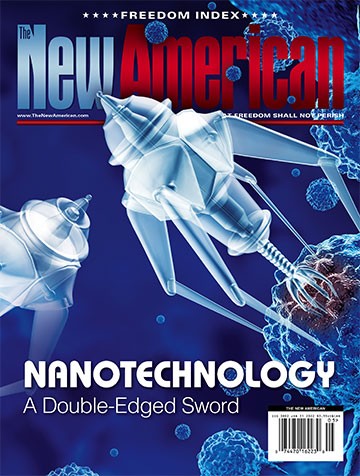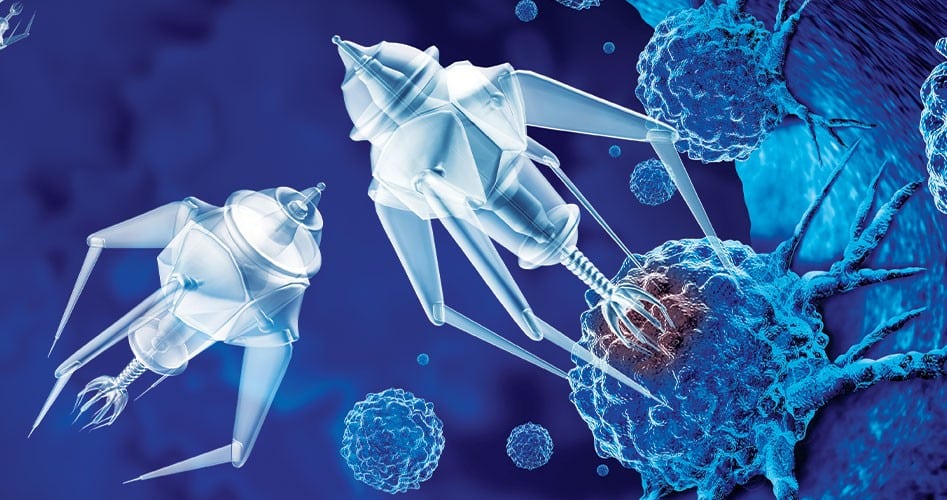Nanotechnology: A Double-Edged Sword
Sometime in the future, a scenario...
Roger’s alarm went off at his customary 5:30 a.m. He’d worked overtime the night before and wasn’t ready to get up. He waved at the alarm clock and it stopped its annoying ring, and Roger dozed off once again.
Ten minutes elapsed. At first, nothing seemed to happen. Someone carefully observing the alarm clock, though, might have noticed a brief and tiny glint of a blink of light from its face as an almost imperceptible speck of what appeared to be dust floated off into the air. That observer might have then noticed, a moment later, that the man dozing on the bed shook his head ever so slightly as that same mote of dust entered a nostril. The man stirred seconds later. His nose wrinkled involuntarily and his hand rubbed his eyes. He sneezed and shot up straight in bed. The irritation went away instantly. Unnoticed by him, the tiny mote flew out his nose and, with that same nearly imperceptible glint of light that accompanied its original separation from the clock, rejoined it.
Roger stood up and took a step away from his bed. He paid no attention to what happened behind him as the bed suddenly grew somewhat transparent, then seemed to pixelate as it dissolved into a cloud of nothingness.
Someone spying on Roger (and, of course, as with all citizens, a swarm of tiny nanosensors watched him at all times, reporting in real time not only his movements and actions, but also all of his vital signs and synaptic activities) would have noticed that the one-room apartment he lived in was now completely empty. The vacuum, however, would not persist long.
As he looked toward the north wall of his allotted 450 square feet of living space, the wall transformed, appearing in the center to pixelate — as did the bed before it — and then solidify, and a window — or what seemed to be a window — appeared. Outside, or what looked to be outside, the view was of a row of soft, green balsam fir trees, their delicate needles glistening with water droplets while a fine mist filtered through the air. Though it appeared to be, this was not a scene outside Roger’s apartment, which was located in the center of the megacity that had grown up around what once was called “Chicago” 40 years ago. Roger didn’t know — couldn’t know — if the scene was real. Travel outside the walls of the megacities was strictly forbidden. No one Roger knew had any idea what was out there. Sometimes rumors swirled around about people who had disappeared over the wall. If anyone did that, Roger thought, they were probably dead. The “natural world” — whatever it was that was out there — was deadly to humans. Everyone knew that.

Mission creep: The Defense Advanced Research Projects Agency (DARPA) funds cutting-edge research in many fields, including nanotechnology, for military applications that will almost certainly find its way into commercial projects as well.
As he looked through the window, a bathroom vanity and sink appeared, water flowing from the faucet at just the right temperature. It poured into the sink, but there was no drain. The water simply disappeared into pixels moments after splashing into the bowl. Roger washed his face. For a moment, as the cool water ran through his hands, he thought about breakfast. He was hungry for a moment, but then the feeling passed as his neural pathways were manipulated to change his sensory perception of hunger while nutrients were delivered in just the right formulation and quantity to his cells automatically by those tiny, imperceptible motes.
His morning routine finished in about seven minutes, his “clothes” assembled by motes instantaneously around him, his commute to work amounted to a few steps across the room, which dissolved around him as the vast, all-pervasive fog of nanomotes swung into action. After the momentary pixelation, his small room disappeared, and assembled in its place was the appearance of a vast, open office, with hundreds of workers reclined in office chairs, their eyes closed as they communicated soundlessly via the nanomotes. Roger’s chair appeared before him moments later. He sat down and closed his eyes. The nanomotes redirected the synapses of his brain. Functioning as a brain-machine interface, they connected him to a central, superintelligent “world mind” and he went to work. Or did he? Were his perceptions real? Roger wasn’t sure. He put those thoughts aside, or had them put aside for him by the nanomotes, and “reality” — whatever that was — troubled him no more.
Stranger Than Fiction
The above account is science fiction — for now. But the foregoing would be one implication of a goal described by an actual forward-looking scientist not that long ago.
A nanotechnology-based “utility fog” similar to that described in the scenario above was proposed by computer scientist J. Storrs Hall at NASA’s Vision 21 conference in 1993. Hall, who earned his Ph.D. from Rutgers University in 1994, described his nanotech “utility fog” in detail:
Imagine a microscopic robot. It has a body about the size of a human cell and 12 arms sticking out in all directions. A bucketful of such robots might form a “robot crystal” by linking their arms up into a lattice structure. Now take a room, with people, furniture, and other objects in it — it’s still mostly empty air. Fill the air completely full of robots.
With the right programming, the robots can exert any force in any direction on the surface of any object. They can support the object, so that it apparently floats in the air. They can support a person, applying the same pressures to the seat of the pants that a chair would. They can exert the same resisting forces that elbows and fingertips would receive from the arms and back of the chair. A program running in the Utility Fog can thus simulate the physical existence of an object.
The Utility Fog operates in two modes: First, the “naive” mode where the robots act much like cells, and each robot occupies a particular function in a given object. The second, or “Fog” mode, has the robots acting more like the pixels on a TV screen. The object is then formed of a pattern of robots, which vary their properties according to which part of the object they are representing at the time. An object can move across a cloud of robots without the individual robots moving, just as the pixels on a CRT remain stationary while pictures move around on the screen.

Cutting edge: A key thought leader in nanotechnology, Eric Drexler, in his 1986 book Engines of Creation, introduced the idea of molecular nanotechnology consisting of “assemblers” working at the nanoscale. (Photo: Oxford Martin Alumni photo)
This vision of a future nanotechnology remains beyond reach — for the moment. But, it is an indisputable fact that nanotechnology is advancing at an accelerating pace. Developments in the science of nanotech have already been commercialized broadly, and more are in progress in laboratories around the world. These promise exciting advances in the performance of materials, in drug delivery and medicine, and in much more besides. But beyond these “everyday” advances, there is a much-darker potential future, one that has nanotech even invading the mind, and contributing to a potential future in which even reality itself might be obliterated.
Fleecing Taxpayers
Chad Mirkin, director of the International Institute for Nanotechnology, George B. Rathmann professor of chemistry, and professor of materials science and engineering, medicine, biomedical engineering, and chemical and biological engineering at Northwestern University, discussed the progress of nanotechnology for Scientific American in October, 2021.
Mirkin credited former President Bill Clinton with kicking off rapid advancements in nanotech research with the federal National Nanotechnology Initiative (NNI) of 2000. Since the creation of that unconstitutional and unethical program — unethical because taxpayers should not have assets forcibly extracted from them and transferred to scientists or anyone else — nanotech research has advanced on the back of billions of dollars of financing.
“Before the NNI, there were people who thought nanotechnology was a gimmick,” Mirkin wrote in Scientific American. “In the wake of the NNI, my university, Northwestern University, made the strategic decision to establish the International Institute for Nanotechnology, which now represents more than $1 billion in pure nanotechnology research, educational programs and supporting infrastructure. Other universities across the U.S. made similar investments, creating new institutes and interdisciplinary partnerships.”
With this taxpayer-funded bonanza, nanotechnology has expanded to such a degree that it is present in almost every aspect of modern technology. It has, for instance, grown in importance in biology and medicine. Mirkin explains: “Size-wise, the nanoscale is comparable to biological structures such as proteins, viruses and DNA. This realization has allowed the preparation of unique classes of hybrid nano-bio structures that have fundamentally changed how we study, track and treat disease.”
Indeed, he concludes, nanotech today is much more than small autonomous machines. “We’ve come a long way from tiny robots,” Mirkin wrote.
But, tiny machines are still a subject of great interest. In 2018, scientists at the Max Planck Institute for Intelligent Systems in Stuttgart, Germany, developed nanorobot technology designed to travel through dense biological tissues. A summary of their research notes that the researchers “developed specially coated nanometer-sized robots that could be moved actively through dense tissue like the vitreous of the eye. So far, the transport of such nano-vehicles has only been demonstrated in model systems or biological fluids, but not in real tissue. Our work constitutes one step further towards nanorobots becoming minimally-invasive tools for precisely delivering medicine to where it is needed.”
The Max Planck researchers are far from the only scientists pursuing innovation in the technology. In fact, according to researchers with the Multi-Scale Robotics Lab (MSRL) at the Institute of Robotics & Intelligent Systems (IRIS) of the Swiss Federal Institute of Technology in Zurich, Switzerland (ETH Zurich), micro- and nanoscale robotics have seen considerable advances in recent years.
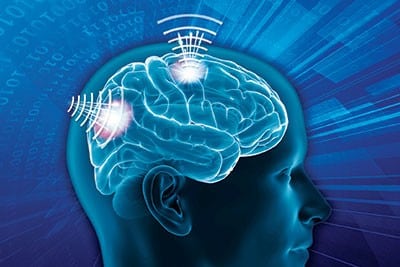
Merging mind and machine: The military research agency DARPA is funding the Next-Generation Nonsurgical Neurotechnology (N3) program to develop a nanotechnology-based, nonsurgically implemented brain-computer interface technology to enable two-way communication between human minds and machines. (Photo: singularityhub.com)
In a review article in December 2017, the ETH Zurich researchers observed that “Micro- and nanorobots are promising devices for biomedical and environmental applications. The past few years have witnessed rapid developments in this field.” These tiny technologies take several forms, the researchers wrote. “Different designs such as helical swimmers, flexible swimmers, surface walkers,” could find applications in the fields of “biomedicine or environmental remediation.” Such robotic devices could be powered by magnetic fields, the researchers report, and they could use magnetic fields for other purposes as well. “The use of magnetic fields for actuation is the most versatile option as this approach enables a wide variety of swimming mechanisms and can simultaneously be exploited for additional functionalities,” the researchers wrote. “Furthermore, magnetically powered micro- and nanorobots are among the most promising miniaturized engines for biomedical applications because they do not adversely interact with tissues in a wide range of conditions.”
Lest these sorts of nanorobots seem to be the stuff of mere scientific speculation, the ETH Zurich researchers provided examples of the technologies built and tested in real-world, if laboratory, situations. One example cited came from a team that “reported the fabrication of artificial helical microswimmers.” In another example, the Zurich scientists pointed to a complex design for a “compound microtransporter with a wirelessly controlled Archimedes screw pumping mechanism.” The researchers noted that “These highly sophisticated microdevices consisted of a magnetically actuated screw with integrated parts encapsulated in a hollow cylinder.” Other research efforts developed swimmers that can “switch between different propulsion mechanisms, rolling, spintop motion and corkscrew swimming, by simply adjusting the direction and the frequency of the rotating magnetic field.”
The researchers also noted that such “swimmers” could be — and have been — developed to be biocompatible and degradable, meaning they could — and will — be used in animals and people in the future. Some of these near-future applications are interesting, if not not downright terrifying in their implications. Consider this headline from New Scientist in 2016: “Mind-controlled nanobots could release drugs inside your brain.”
This is not science fiction. New Scientist reported, “A man has used thought alone to control nanorobots inside a living creature for the first time. The technology released a drug inside cockroaches in response to the man’s brain activity.”
When most people think of robots, nano or otherwise, they think of metallic machines. But nanobot technology, especially that designed to work within biological systems, is quite a bit more expansive than that.
Scientists in Israel have built nanobots out of DNA. These have “shell-like shapes that drugs can be tethered to,” New Scientist noted. “The bots also have a gate, which has a lock made from iron oxide nanoparticles. The lock opens when heated using electromagnetic energy, exposing the drug to the environment. Because the drug remains tethered to the DNA parcel, a body’s exposure to the drug can be controlled by closing and opening the gate.”
With a little imagination, you can think of some of the many ways this could be used — both good and bad.
Nanobots at War
Not surprisingly, the U.S. military is extremely interested in nanotechnology due to its considerable relevance to military applications. Much high-end military research is conducted or funded by the Defense Advanced Research Projects Agency (DARPA). In fact, DARPA has long been interested in nanotech’s military relevance. Among other things, the agency wants to use nanotechnology to create a more instantaneous means of allowing the human mind to communicate with machines. According to Live Science, the effort is being funded under the agency’s Next-Generation Nonsurgical Neurotechnology (N3) program. “Participants are tasked with developing technology that will provide a two-way channel for rapid and seamless communication between the human brain and machines without requiring surgery,” the website reported.
The key phrase to remember from that bit of reporting is “a two-way channel.” This implies that the human mind will be receiving data as well as sending it if the DARPA program succeeds. “The agency is interested in systems that can read and write to 16 independent locations in a chunk of brain the size of a pea with a lag of no more than 50 milliseconds within four years,” Live Science reported, based on information provided by Jason Robinson of Rice University, who was leading one of the teams receiving DARPA funding. The Live Science report appeared in May 2019; as of mid-2021, slightly more than 50 percent of DARPA’s four-year timeline had elapsed.

Disease cures: Nanotechnology offers considerable promise for the development of treatments for many diseases, including Alzheimer’s, by using such technologies as magnetoelectric nanoparticles (MENPs). (Photo credit: AP Images)
One of the researchers working on a solution that has interested DARPA, among others, is Sakhrat Khizroev, professor of electrical and computer engineering at the University of Miami. A university press release noted that Professor Khizroev is using magnetoelectric nanoparticles (MENPs) “to talk to the brain without wires or implants.”
According to Khizroev, “Other efforts have used external instruments like microelectrodes to try to solve the mysteries of the brain, but because of its complexity and difficulty in accessing, such methods can only go so far.” He continued, “There are 80 billion neurons in the human brain, so imagine how difficult it would be to attach 80 billion microelectrodes to access every single neuron. The only way to truly tap in is wirelessly — through nanotechnology.”
How does he propose to tap into the brain? The MENPs that he intends to use are “two thousand times thinner than a human hair” and travel through the bloodstream, crossing the blood-brain barrier unimpeded. Once in the brain, they can be used to tap into a person’s thoughts. To accomplish this, Khizroev and his researchers intend to inject millions of MENPs “intravenously into the body.”
“Our brains are pretty much electrical engines, and what’s so remarkable about MENPs is that they understand not only the language of electric fields but also that of magnetic fields,” Khizroev said, according to the university’s press release. “Once the MENPs are inside the brain and positioned next to neurons, we can stimulate them with an external magnetic field, and they in turn produce an electric field we can speak to, without having to use wires.”
This has important implications for the diagnosis and treatment of neurological diseases, including, perhaps, Alzheimer’s. The research, though, may have a dark side, and as such has attracted DARPA. The agency “has funded the College of Engineering professor to develop a wireless brain-computer interface that would enable fast, effective, and intuitive hands-free interaction with military systems by able-bodied service members. The so-called BrainSTORMS project is now in its second phase and is expected to be completed in 2024.”
The disruptive potential of the technology was noted by Professor Khizroev. “Right now, we’re just scratching the surface,” he said. Remarking on the potential impact of the technology on human life, he continued, “We can only imagine how our everyday life will change with such technology.”
Merging Mind and Machine
The DARPA N3 program is being run by Dr. Al Emondi, former chief technology officer for the Space and Naval Warfare Systems Center (SPAWAR) Atlantic in Charleston, South Carolina. At DARPA, he focuses on “neurotechnology and human-machine interaction” with an emphasis on seeking “novel neural interface system architectures applicable to broad user populations and improving the performance of neural interfaces and their application potential through the use of third-wave artificial intelligence.”
That’s a mouthful of jargon, but in a press release from DARPA, Emondi explained in simpler terms the expected impact of the research being conducted under his N3 program: “If N3 is successful, we’ll end up with wearable neural interface systems that can communicate with the brain from a range of just a few millimeters, moving neurotechnology beyond the clinic and into practical use for national security.”
Emondi described for the BBC the potential impact of DARPA’s N3 project. “The ability to really change the world doesn’t happen often in a career,” he said. “If we can build a neural interface that’s not invasive, we will have opened up the door to a whole new ecosystem that doesn’t exist right now.”
That ecosystem will depend heavily on artificial intelligence. “As the AI becomes better, the systems we are interoperating with are going to become more autonomous,” Emondi told the BBC.

Artificial intelligence: Many theorists and futurists have warned that as artificial intelligence becomes more powerful, human minds will fall behind. (Photo credit: Photo: metamorworks/iStock/GettyImagesPlus)
Another scientist who spoke to the BBC also emphasized the role of AI, but warned that it represents a danger to human existence. “Our artificial intelligence systems are getting better and better,” Michael Wolmetz told the BBC. Wolmetz, who serves as senior scientist with the Intelligent Systems Group in the Research & Exploratory Development Department at the Johns Hopkins Applied Physics Laboratory, continued, warning that “there is a question of at what point humans become the weakest link in the systems that we use. In order to be able to keep up with the pace of innovation in artificial intelligence and machine learning, we may very well need to directly interface with these systems.”
This would seem to be technology that gets us close to another aspect of the transhumanist future envisioned by Ray Kurzweil, longtime innovator, Google engineer, and leading proponent of transhumanism. Transhumanism is a movement that aims to bring about the eventual merger of the human mind with machine minds. Critics would say, accurately, that what the transhumanists seek is the extinction of humans as they exist today. At a TED presentation in 2014, Kurzweil explained, “We’ll have nanobots that … connect our neocortex to a synthetic neocortex in the cloud.… Our thinking will be a ... biological and non-biological hybrid.”
The obvious commercial application for this technology in the short term is virtual reality, an area undergoing rapid development. In late September 2021, Facebook announced that it was changing its name to Meta and would be investing millions of dollars in development of what it and others are calling the “metaverse.” The company envisions this to be a merger of analog reality with digital virtual reality in which the real world is blended with and eventually supplanted by the virtual. Notably, the World Economic Forum — chief enabler of UN-aligned transhumanism — supports the idea and says that implementation of the idea will bring significant social, economic, and cultural “transformations” occurring “at an accelerated pace and universal scale.”
According to Facebook, “the ‘metaverse’ is a set of virtual spaces where you can create and explore with other people who aren’t in the same physical space as you. You’ll be able to hang out with friends, work, play, learn, shop, create and more.” To bring this into existence, say Andrew Bosworth and Nick Clegg — vice presidents of Facebook Reality Labs and Facebook Global Affairs, respectively — their company will “work with experts in government, industry and academia to think through issues and opportunities in the metaverse. For instance,” they continue, “its success depends on building robust interoperability across services, so different companies’ experiences can work together. We also need to involve the human rights and civil rights communities from the start to ensure these technologies are built in a way that’s inclusive and empowering.” Initial Facebook collaborators on the project include the Organization of American States — a “regional agency” of the United Nations — the organization Women In Immersive Tech, and three organizations in Africa: Africa No Filter, Electric South, and Imisi3D.
Now, consider the Facebook metaverse in light of Sakhrat Khizroev’s MENPs and his approach to using them as a brain-computer interface. Current extended-reality and virtual-reality technology on the consumer side requires a visual interface using either VR goggles or “smart” glasses. Consider the possibility — indeed the likelihood — that a nanotech-based brain-computer interface could replace crude visual-interface hardware. Already, millions of people worldwide spurn the real world for existing social media and immersive video games. Nanotech promises to merge the real and the virtual, potentially embedding the metaverse directly into the human mind.
Science Fiction and Science Fact
What will be real and what will be metaverse “fake” in a near-term future with this technology employed ubiquitously? The late science-fiction master Philip K. Dick repeatedly envisioned this in his works describing future worlds where artificial reality could hardly be distinguished — indeed was indistinguishable — from actual, material reality. Though most well-known for the story Do Androids Dream of Electric Sheep?, made famous by director Ridley Scott’s 1982 masterpiece film adaptation Blade Runner, a more appropriate Philip K. Dick story for our current and near-term future age is We Can Remember It for You Wholesale. The story was the basis for the 1990 film Total Recall starring Arnold Schwarzenegger that saw character Doug Quail, pining for an adventure on Mars that he couldn’t afford, seek out a sort of virtual-reality alternative. Visiting a “Rekal” shop, Quail inquired about the virtual memory he might purchase of a two-week Mars vacation.
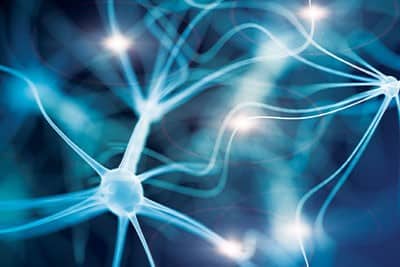
Tech revolution? Scientist and researcher Sakhrat Khizroev says neural nanotech could become a revolutionary technology. (Photo credit: ipopba/iStock/GettyImagesPlus)
Meeting with the Rekal salesman, Quail was assured the memory of the trip that he received would be indistinguishable — and even better — than a real memory. The salesman, Dick wrote, “glanced up keenly at Quail. ‘You’ll know you went, all right,’ he said. ‘You won’t remember us, won’t remember me or ever having been here. It’ll be a real trip in your mind; we guarantee that. A full two weeks of recall; every last piddling detail. Remember this: if at any time you doubt that you really took an extensive trip to Mars you can return here and get a full refund. You see?”
When questioned by Quail, who said that, nonetheless, he wouldn’t have actually gone to Mars, the salesman replied that the implanted memory of the trip would be better than a real memory. From Dick’s story:
“Is an extra-factual memory that convincing?” Quail asked.
“More than the real thing, sir. Had you really gone to Mars as an Interplan agent, you would by now have forgotten a great deal; our analysis of true-mem systems — authentic recollections of major events in a person’s life — shows that a variety of details are very quickly lost to the person. Forever. Part of the package we offer you is such deep implantation of recall that nothing is forgotten. The packet which is fed to you while you’re comatose is the creation of trained experts, men who have spent years on Mars; in every case we verify details down to the last iota. And you’ve picked a rather easy extra-factual system; had you picked Pluto or wanted to be Emperor of the Inner Planet Alliance we’d have much more difficulty ... and the charges would be considerably greater.”
Will We Can Remember It for You Wholesale still be fiction two years from now? Three years? Ten? What will happen, what will be possible, when the chain anchoring human experience to reality is fully and completely severed?
Reaching transhumanist nirvana through nanotechnology assumes, however, that other apocalyptic scenarios imagined by some nanotech pioneers do not play out.
Gray Goo?
You can’t talk about the potential impact of nanotechnology and nanorobotics without talking about Eric Drexler. One of the more forward-thinking and brilliant scientists of the last 50 years, Drexler is a nanotechnology pioneer and author of Engines of Creation: The Coming Era of Nanotechnology. Published in 1986, the book introduced the idea of molecular nanotechnology consisting of “assemblers” working at the nanoscale. These would be able to build a copy of themselves or create most other items, assembling them molecule by molecule.
This sounded preposterous to many at the time, but self-assembly is already a reality. For example, researchers at China’s Beihang University in Beijing reported on their work on “artificial flexible sperm-like” nanorobots that were “based on self-assembly” in a 2021 preprint research paper.
Specifically, the Chinese researchers proposed an “artificial flexible sperm-like nanorobot synthesized via a facile self-assembly strategy using Fe3O4 [magnetite] nano beads and flexible polymer flagella for the first time, which can generate bidirectional flagellar propulsion under precessing magnetic fields.” The researchers claim in the paper describing their work to have succeeded in creating and testing their proposed nanorobots. Other research of this sort on related subjects is not difficult to locate in the literature.
The technology is not yet to the level of Drexler’s envisioned, dangerous assemblers, but it demonstrates technological development in that direction.
This makes Drexler’s ideas of continuing relevance, and among those ideas is included the possibility of extreme risk in the form of self-assembling nanobots that could eat the world and turn it into “gray goo.” In Engines of Creation, Drexler posited that self-assembling nanorobots could consume all the materials of the earth in pursuit of their simple-minded goal of self-replication. According to Drexler, “‘Plants’ with ‘leaves’ no more efficient than today’s solar cells could out-compete real plants, crowding the biosphere with an inedible foliage. Tough omnivorous ‘bacteria’ could out-compete real bacteria: They could spread like blowing pollen, replicate swiftly, and reduce the biosphere to dust in a matter of days. Dangerous replicators could easily be too tough, small, and rapidly spreading to stop — at least if we make no preparation. We have trouble enough controlling viruses and fruit flies.”
This, said Drexler, had become known among “the cognoscenti of nanotechnology” as “‘the gray goo problem.’” He continued: “Though masses of uncontrolled replicators need not be gray or gooey, the term ‘gray goo’ emphasizes that replicators able to obliterate life might be less inspiring than a single species of crabgrass.” To this, Drexler added a warning. “The gray goo threat makes one thing perfectly clear,” he wrote, continuing, “We cannot afford certain kinds of accidents with replicating assemblers.”

Bots on the brain: Transhumanism seeks to create biodigital human hybrids. Nanotechnology is poised to play a significant role in that dubious and dangerous effort. (Photo credit: Polina Shuvaeva/iStock/GettyImagesPlus)
“Gray goo” is not a current threat, and likely won’t be, at least for the near-term future. More likely is that nanotech innovations could be used for evil purposes. “Unfortunately, as with nuclear technology, it is far easier to create destructive uses for nanotechnology than constructive ones,” wrote famed computing pioneer and Sun Microsystems co-founder Bill Joy in a now-famous essay for Wired magazine in April 2000. In that essay, titled “Why the Future Doesn’t Need Us,” Joy wrote, “Nanotechnology has clear military and terrorist uses, and you need not be suicidal to release a massively destructive nanotechnological device — such devices can be built to be selectively destructive, affecting, for example, only a certain geographical area or a group of people who are genetically distinct.”
Scientists and researchers concerned with “existential risks” continue to point to nanotechnology as one innovation that poses distinctly significant threats to the survival of human civilization.
Physicist and author Luis Del Monte, who reports he was previously “a Honeywell Executive Director,” states that during his career “he led hundreds of physicists, engineers, and technology professionals engaged in micro to nanotechnology development for the Department of Defense (DoD) and commercial applications.” In 2017 he authored the book Nanoweapons: A Growing Threat to Humanity.
According to Del Monte, the first “singularity” of the sort envisioned by Ray Kurzweil — when general AI exceeds human cognitive capabilities — will lead to a second singularity involving self-replicating nanobots. Writing for HuffPost in 2017, Del Monte argued, “Given the strong symbiotic relationship between computer power and nanotechnology, we may see both technologies progressing faster than their historical trends. My rationale is that an advance in one technology fosters advances in the other.” He continued, “I judge this synergy may accelerate the advancement of both technologies.”
On his own website, Del Monte described what he foresaw as the outcome of the development of self-replicating nanobots. His vision differs from Drexler’s gray goo (which Drexler in recent years has backed away from a bit), but is likely more realistic.
“Self-replicating nanobots are the ultimate invention,” Del Monte said, pointing out that they would help solve problems on one hand, while proving extremely dangerous on the other. “In medicine,” he pointed out, “they will flow through our blood preventing diseases and curing injuries. In military applications, they will have the capability to completely destroy an adversary, from its populace to its structures.”
Unfortunately, he noted, nanobots could escape control, presenting considerable risks as artificial analogues to biological microbes such as bacteria and viruses. More complex biological systems, including mammals such as humans, have developed sophisticated immune systems in parallel with the existence of biological pathogens, and thus have an innate ability to protect themselves — if not always successfully — from them. There would be no such protection from artificial microbes — nanobots — if they escaped control.
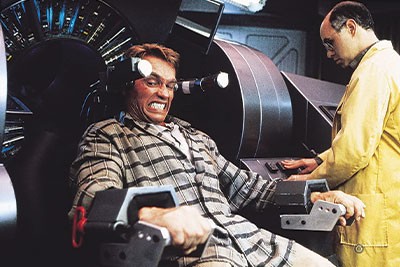
Enter the extra-factual: In Total Recall, the blockbuster film adaptation of the Philip K. Dick short story We Can Remember It for You Wholesale, a future technology was used to implant realistic memories into the human mind. With nanotechnologies such as those being explored by several DARPA-funded labs, such a future might not be far off.
“Strategic nanoweapons, like their nuclear counterparts, pose a threat to humanity,” Del Monte argues. “The major issue is control. Will we be able to deploy strategic nanoweapons and maintain control over them? If, for example, we lost control of self-replicating nanobots, we would face a technological plague, one that we currently have no way of stopping.”
Nanotechnology is used widely today in many diverse applications, and continuing research promises near-term future innovation resulting in outcomes likely to be similar to forecasts from early innovators and researchers in the technology. Tied directly to AI and enabled by advanced 5G communications technologies, nanotechnologies are both a boon and a danger to mankind. While they will allow fabulous advances — especially in medicine and in materials science — they also have direct application to reality-distorting and reality-obliterating outcomes such as the metaverse plan outlined by Facebook.
Such a world, in which the human mind could be written to directly via a nanotech brain-computer interface, would be one in which human free will is at risk. Today, in some parts of Europe and elsewhere, a digital vaccine ID is required to access goods, services, and activities. Proposals exist to implant that ID via microchip within the human body. In China, a social-credit system controls access to goods, services, and activities based on the Communist Party’s evaluation of a person’s behavior. With a nanotech-mediated metaverse, all of these things and more can be embedded directly in a person’s mind. Imagine, if you will, the horror of big-tech censorship, propaganda, and control algorithms running with direct and controlling access to your mind. It’s a chilling thought.
If the transhumanists have their way, nanotechnologies will help make “the matrix” real, and it will be embedded directly into human biology and the human mind.
If that happens, there will be no escape.
Dennis Behreandt is publisher of The New American. This article is excerpted and adapted from his soon-to-be-published book End Game.


